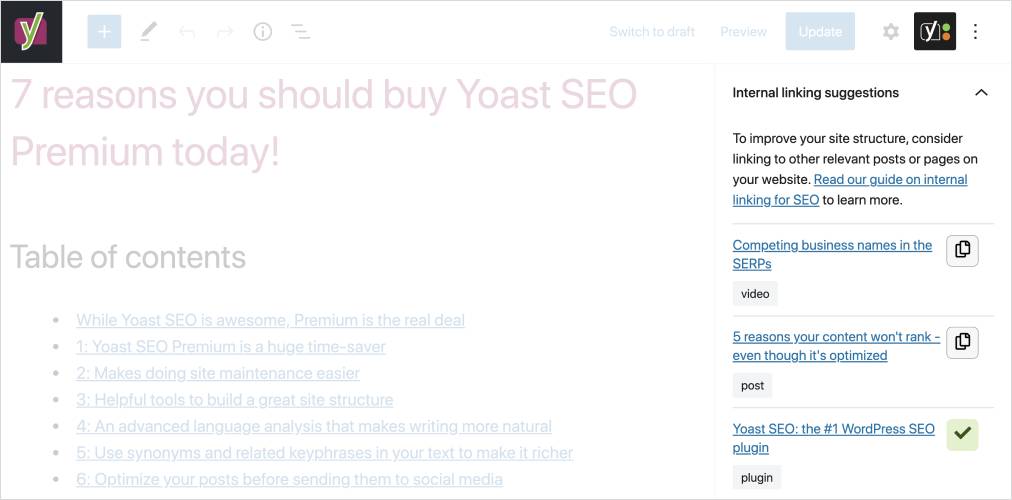Internal Linking in 2025: Best Practices to Boost Your SEO

Internal linking in 2025 is one of the most powerful yet overlooked strategies to improve your site’s SEO. By connecting related pages, you guide visitors through valuable content and help search engines understand your site’s structure. This improves crawlability, distributes link equity, and boosts topical relevance. The best part? You can optimize internal links without changing your entire site.
Table of Contents
ToggleStart by adding relevant links to existing content, building strong topic clusters, and fixing orphan pages. If you want a complete strategy that combines internal linking with other essential elements, check out our On-Page SEO Guide for practical tips to maximize your rankings.
What is Internal Linking?
Internal linking means creating hyperlinks that connect one page on your website to another page within the same site. These links act like pathways, guiding visitors through your content while helping search engines understand your site’s structure.
Without these internal links, users and Google both get lost. A clear internal linking strategy makes your site easier to navigate, distributes link authority, and keeps people engaged longer.
Why Does Internal Linking Matter in 2025 for SEO?
In 2025, search engines are smarter than ever. They’re looking for strong topical connections and user-friendly experiences. When you use internal links strategically, you’re showing search engines exactly which pages matter most and how they relate to each other.
For you, it means lower bounce rates, better engagement, and more pages ranking in search results. The key is relevance. A well-placed link to a related article keeps readers exploring, which tells Google your content delivers value.
AI-driven algorithms prioritize context and intent over simple keywords. So your internal links must feel natural and support the reader’s journey, not just your ranking strategy.
Best Practices for Internal Linking in 2025
Now, I’ll cover 10 internal linking best practices that will make your site more user- and search-engine-friendly.
1. Mix Up Your Anchor Text
Anchor text tells search engines what the linked page is about. Using the same anchor repeatedly looks unnatural and may hurt your SEO.
Exact match
An exact match means your anchor text matches the target keyword perfectly. For example, if you’re linking to a page about “internal linking best practices,” your anchor text would be exactly that phrase.
This type is powerful for reinforcing relevance but use it sparingly. Over-optimization can raise red flags. The rule I use? Keep exact-match anchors under 20% of your total internal links.
Partial Match
Partial match includes part of your target keyword, but with extra words for context. For instance, “best practices for internal linking in 2025” instead of just “internal linking best practices.”
This approach feels more natural to readers and still gives search engines the right signals.
Branded
Branded anchors use your business or site name. For example, “Learn more on [YourBrand].”
While this doesn’t target a keyword directly, it builds brand authority and trust. Google values natural link profiles, and branded anchors help create that balance.
Compound
Compound anchors combine your brand name with a keyword. For example: “YourBrand’s internal linking strategies.”
This is excellent for promoting both your brand and your topic authority.
Related
Related anchors use synonyms or related phrases instead of the exact keyword. For example: “site structure tips” or “how to organize your pages.”
This signals to Google that your content covers the topic broadly, which is crucial for semantic SEO in 2025.
2. Build Pillar Pages
A pillar page is the backbone of your topic cluster. It’s a comprehensive guide that links to related subtopics and receives links back from them. This matters because search engines love organized, hierarchical structures that clearly show expertise and coverage.
Start by identifying your core topics (those broad themes your audience cares about most). Create a detailed pillar page for each topic, then write supporting articles that link back to it. This creates a topical authority hub, making it easier for search engines to understand your site’s hierarchy and context.
Take these steps to start building pillar pages:
- Choose 3-5 core topics for your site.
- Write in-depth pillar pages covering those topics.
- Link all related blog posts to the pillar page, and vice versa.
This strategy not only improves SEO but also helps users navigate your content easily.
3. Fix Your Orphan Pages (Pages Without Links)
An orphan page is a webpage on your site that isn’t linked to from any other page, making it inaccessible to users and search engine crawlers through internal navigation.
In SEO terms, if a page has no internal links, search engines struggle to find and rank it. Users also miss valuable content because they can’t navigate to it easily.
In 2025, solving this is easier than ever, but it still requires attention. Start by auditing your website to find orphan pages. You can use tools like Screaming Frog, Sitebulb, or Google Search Console. Look for pages with zero internal links pointing to them.
4. Connect Related Content
Your content should never live in isolation. If two articles cover similar or complementary topics, link them together. This approach signals topical relevance to Google and provides readers with a smoother journey through your site.
Here’s how to do it effectively:
- Start with categories: Group your articles by topic clusters.
- Add contextual links: When you mention a concept covered in another post, link to it naturally.
- Use descriptive anchors: Avoid “click here.” Instead, use phrases that explain what readers will find.
Example: If you’re writing about on-page SEO and mention internal linking, link to your dedicated internal linking article/blog.
This practice not only helps your SEO but also keeps users engaged longer, reducing bounce rates and increasing conversions.
5. Link From High-Authority Pages to New or Low-Authority Pages
Not all your pages have equal power. Some earn strong authority from backlinks or high engagement, while new pages start with zero. Linking from an established, high-performing page to a new or weaker one passes authority and helps it rank faster.
Here are some steps you can take right now:
- Identify your top 10 highest-authority pages using tools like Ahrefs or SEMrush.
- Find natural anchor text opportunities within these pages to link to new or important content.
- Keep it relevant
6. Update Old Content With New Links
Your older posts might still attract traffic, but if they don’t link to your newer content, you’re missing out on both SEO and user engagement opportunities. Refreshing old content with new internal links is one of the quickest wins for SEO goals.
7. Use Do-Follow Links for Internal Navigation
Internal links should almost always be do-follow, allowing search engines to pass authority and discover new pages. Adding “nofollow” to internal links can cut off important pages from receiving link equity.
The only time you might use nofollow internally is for login pages, admin sections, or tracking links.
8. Link to Pages That Are Just One Step Deeper
When linking internally, aim to keep users as close to the homepage as possible in terms of click depth. Pages buried four or five clicks away from the homepage often struggle to rank.
Search engines consider site architecture and click depth a ranking factor. Your internal links can help flatten the structure.
9. Use Internal Linking to Support Topical Relevance
Internal linking in 2025 is all about context. When your links connect related content, you send strong signals about your topical authority. This is essential in an era where semantic SEO and entity-based search dominate.
Don’t just throw random links into your content. Each link should serve a purpose:
- Guide users to related resources.
- Reinforce your content clusters.
- Build depth on your primary topics.
Done right, this creates a web of relevance that both users and search engines love.
10. Limit the Number of Internal Links Per Page
Too many internal links on a page can hurt your SEO. It looks spammy and dilutes link equity. Aim for quality, not quantity.
It’s difficult to pinpoint a “perfect” number, but here’s what works for me:
- Blog posts: 5-10 internal links depending on length or around 1-2 internal links per 300 words.
- Pillar pages: 15-20 internal links, if the structure is well organized.
If a link genuinely helps the reader, you want to include it.
3 Best Internal Linking Tools in 2025
If you want to master internal linking in 2025, the right tools can make a huge difference. Below are three tools I personally recommend for different types of users and websites.
1. Link Whisper
If you’re running a WordPress site and want quick internal linking suggestions, Link Whisper is your go-to. It scans your entire site and recommends relevant links based on your content. The interface is beginner-friendly, yet powerful.

When to use it:
Use Link Whisper if you’re on WordPress and want an effortless way to keep your internal links fresh and relevant.
Pros:
- Easy to install and set up in minutes
- Provides smart internal link suggestions inside the WordPress editor
- Includes broken link reporting and link tracking
- Supports Google Search Console integration for better link insights
Cons:
- Suggestions can sometimes feel too broad or irrelevant
- Limited to WordPress sites
- Anchor text customization is a bit basic
2. LinkStorm (Non-Wordpress Websites)
Running on a custom CMS or an e-commerce platform? LinkStorm is your go-to internal linking tool for 2025. It’s designed for non-WordPress sites, making it perfect for SaaS companies, large online stores, or publishers with complex architectures. LinkStorm uses AI to recommend contextually relevant links across your site structure

When to use it:
Choose LinkStorm if you manage a large website outside WordPress and need advanced automation for internal links.
Pros:
- Works with virtually any CMS or custom-built platform
- AI-driven contextual link suggestions for better topical relevance
- Bulk linking capabilities save hours of manual work
- Great for scaling internal linking on large websites
Cons:
- More expensive than most WordPress-only tools
- Requires initial setup and configuration
- Advanced features might overwhelm beginners
3. YoastSEO Premium (For Beginners)
If you’re completely new to SEO, YoastSEO Premium is a simple starting point for internal linking. It’s primarily an SEO plugin, but the premium version includes an internal linking feature that suggests related posts while you write.

When to use it:
Use YoastSEO Premium if you’re just starting out and want an all-in-one SEO tool with basic linking help.
Pros:
- Perfect for beginners who need simple guidance
- Built-in suggestions appear as you write new content
- Combines internal linking with other SEO features (meta tags, readability, etc.)
- Reduces the learning curve for small websites
Cons:
- Internal linking feature is basic compared to specialized tools
- Premium version required for linking suggestions
- Limited control over advanced linking strategies


